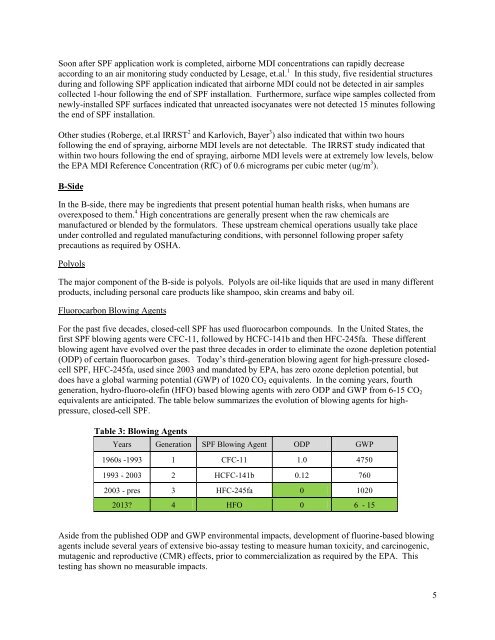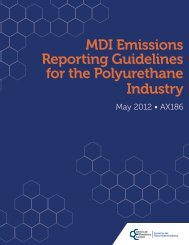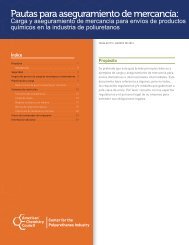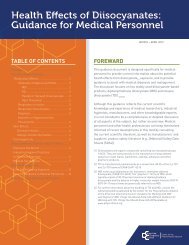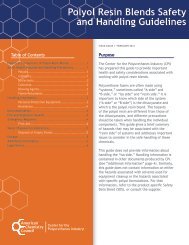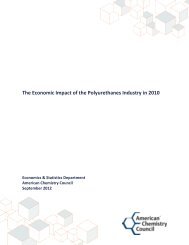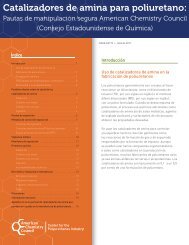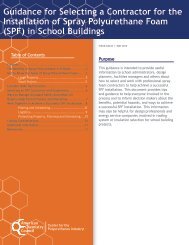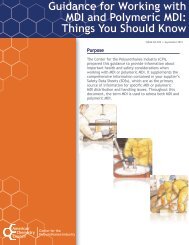Spray Polyurethane Foam: Benefits for Passive Houses
Spray Polyurethane Foam: Benefits for Passive Houses
Spray Polyurethane Foam: Benefits for Passive Houses
You also want an ePaper? Increase the reach of your titles
YUMPU automatically turns print PDFs into web optimized ePapers that Google loves.
Soon after SPF application work is completed, airborne MDI concentrations can rapidly decrease<br />
according to an air monitoring study conducted by Lesage, et.al. 1 In this study, five residential structures<br />
during and following SPF application indicated that airborne MDI could not be detected in air samples<br />
collected 1-hour following the end of SPF installation. Furthermore, surface wipe samples collected from<br />
newly-installed SPF surfaces indicated that unreacted isocyanates were not detected 15 minutes following<br />
the end of SPF installation.<br />
Other studies (Roberge, et.al IRRST 2 and Karlovich, Bayer 3 ) also indicated that within two hours<br />
following the end of spraying, airborne MDI levels are not detectable. The IRRST study indicated that<br />
within two hours following the end of spraying, airborne MDI levels were at extremely low levels, below<br />
the EPA MDI Reference Concentration (RfC) of 0.6 micrograms per cubic meter (ug/m 3 ).<br />
B-Side<br />
In the B-side, there may be ingredients that present potential human health risks, when humans are<br />
overexposed to them. 4 High concentrations are generally present when the raw chemicals are<br />
manufactured or blended by the <strong>for</strong>mulators. These upstream chemical operations usually take place<br />
under controlled and regulated manufacturing conditions, with personnel following proper safety<br />
precautions as required by OSHA.<br />
Polyols<br />
The major component of the B-side is polyols. Polyols are oil-like liquids that are used in many different<br />
products, including personal care products like shampoo, skin creams and baby oil.<br />
Fluorocarbon Blowing Agents<br />
For the past five decades, closed-cell SPF has used fluorocarbon compounds. In the United States, the<br />
first SPF blowing agents were CFC-11, followed by HCFC-141b and then HFC-245fa. These different<br />
blowing agent have evolved over the past three decades in order to eliminate the ozone depletion potential<br />
(ODP) of certain fluorocarbon gases. Today’s third-generation blowing agent <strong>for</strong> high-pressure closedcell<br />
SPF, HFC-245fa, used since 2003 and mandated by EPA, has zero ozone depletion potential, but<br />
does have a global warming potential (GWP) of 1020 CO2 equivalents. In the coming years, fourth<br />
generation, hydro-fluoro-olefin (HFO) based blowing agents with zero ODP and GWP from 6-15 CO2<br />
equivalents are anticipated. The table below summarizes the evolution of blowing agents <strong>for</strong> highpressure,<br />
closed-cell SPF.<br />
Table 3: Blowing Agents<br />
Years Generation SPF Blowing Agent ODP GWP<br />
1960s -1993 1 CFC-11 1.0 4750<br />
1993 - 2003 2 HCFC-141b 0.12 760<br />
2003 - pres 3 HFC-245fa 0 1020<br />
2013? 4 HFO 0 6 - 15<br />
Aside from the published ODP and GWP environmental impacts, development of fluorine-based blowing<br />
agents include several years of extensive bio-assay testing to measure human toxicity, and carcinogenic,<br />
mutagenic and reproductive (CMR) effects, prior to commercialization as required by the EPA. This<br />
testing has shown no measurable impacts.<br />
5


